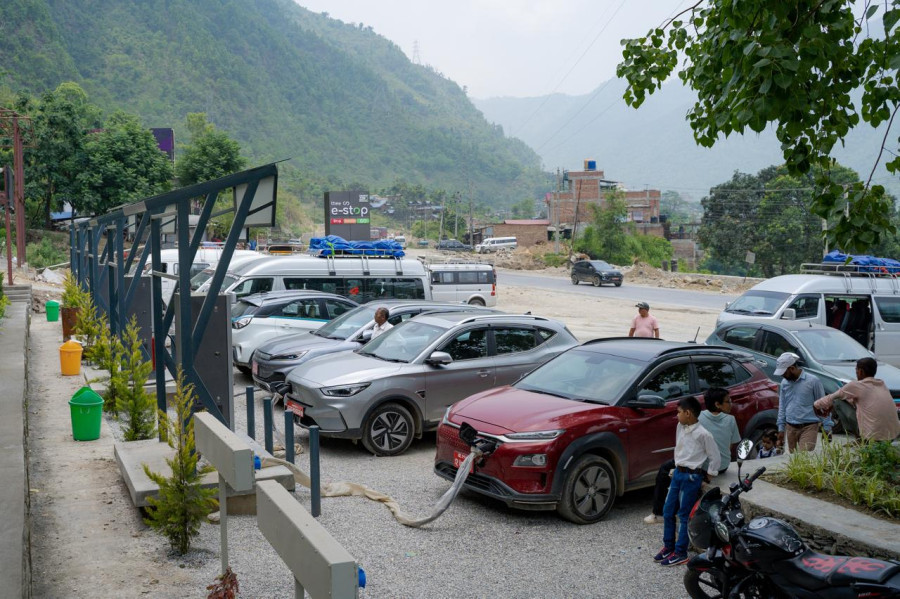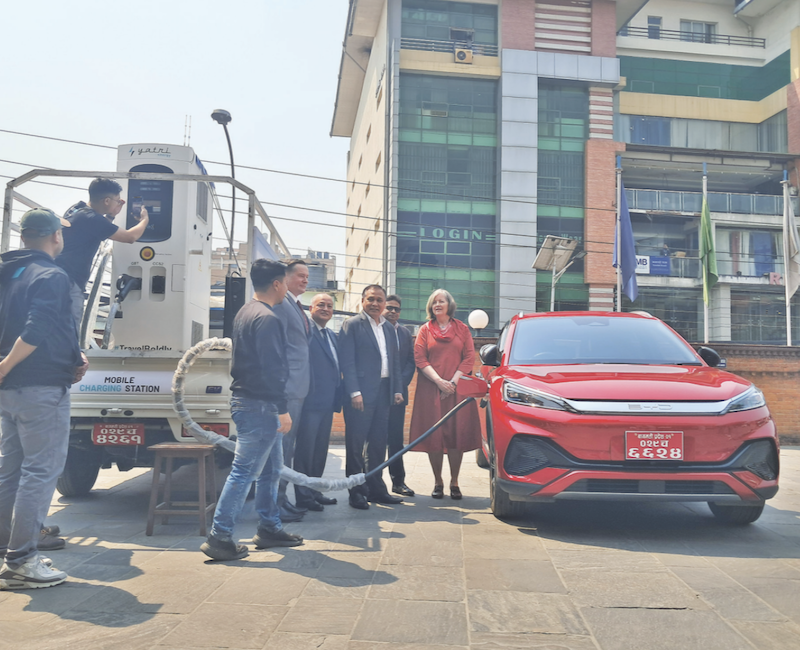Money
Nepal’s economy has slowed down. Electric vehicle sales haven’t
In the past five years, imports of passenger EVs from China jumped 35 fold, suggesting EV adoption in Nepal is now outpacing conventional combustion vehicles.
Krishana Prasain
In 2019-20, Nepal imported 236 units of passenger electric vehicles (EVs) from China worth some Rs674 million.
In the past five years, imports of EVs from China jumped 35 times, suggesting EV adoption in Nepal is now outpacing that of conventional combustion vehicles which use engines that burn fossil fuels, such as petrol or diesel.
The EVs have overtaken conventional combustion vehicles.
The imports of fossil fuel-consuming passenger vehicles were 10,310 units worth Rs9.24 billion in 2019-20. After four years, in the first 11 months of the current fiscal year, imports of conventional combustion vehicles were down to 3,537 units worth Rs4.21 billion
However, overall vehicle imports have jumped from Rs65.02 billion in 2019-20 to Rs80 billion in the first 11 months of 2023-24.
According to the Department of Customs, Nepal imported 11,466 units of EVs worth Rs29 billion in the first 11 months of the current fiscal year, or by mid-June. The imports were 3,870 units worth Rs11.23 billion in the same period last fiscal year.
Of the total EV imports, a third came from China.
Customs data show that Nepal imported 7,931 units of EVs from China, accounting for 69 percent of the total EV imports in the first 11 months of the current fiscal year. This translates to Rs21 billion in value.
After China, the majority of EVs were imported from India.
In the review period, imports from India amounted to Rs6 billion, or 3,277 units. Until the last fiscal year, India was Nepal’s top EV supplier.
The data show that Nepal imported 2,205 EVs worth Rs5.94 billion from India in the last fiscal year. In the same period, imports from China were 1,269 units worth Rs3.75 billion.
Nepal’s imports of EVs jumped sharply by 158.23 percent in the first 11 months of the current fiscal year.
Importers say BYD, a Chinese multinational, has taken over the Nepali market.
The government collected revenue of Rs13.06 billion from the import of EVs in the review period.
Akash Golchha, senior vice president of the Nepal Automobile Dealers Association, said the ongoing economic slowdown has not stopped Nepalis from buying EVs. However, petrol or diesel-run vehicle sales could have been better.
EV sales and orders saw a dramatic surge before the budget was announced on May 28.

Cimex Inc Pvt Ltd, the authorised distributor of BYD Auto Industry Co Ltd in Nepal, said it had achieved a milestone by delivering 50 cutting-edge BYD EVs in a single day on May 18. According to the company, all 50 units were sold from its service centre at Guheshwari, Kathmandu.
According to Cimex, the company imported 4,000 EVs in the first 11 months of the current fiscal year. The import of Chinese EVs is high due to their larger production compared to India, said the company, which is among the top EV brands in Nepal.
BYD’s Atto and Dolphin are the most preferred models among Nepali customers. With the recent hike in excise and customs duties, the company said the new price list of BYDs will be unveiled soon.
“There was fear among buyers that the government may raise duty on EVs in the budget. As a result, the demand surged dramatically,” said Golchha. “The high import increased the stock of EVs.”
Automobile dealers said that the government hiked the duty on EVs by 10 percent in the budget for the coming fiscal year 2024-25, which, however, may not impact the sales.
Golchha said the government did not make drastic changes in the import duty of EVs in the budget, which may help EV sales boom in the coming days. “The EV demand will grow at a faster pace.”
Auto dealers say the import boost for EVs is mainly due to banks’ easy financing. Banks lend up to 90 percent of the vehicle’s cost.
Finance Minister Barsha Man Pun, in the annual budget for the upcoming fiscal year, revised the customs and excise duty rates on the import of EVs. The customs duty on EVs of up to 50 kW has been increased to 15 percent from 10 percent, while a 5 percent excise duty has been imposed on them.
Likewise, the government increased the customs and excise duties on EVs of 50-100 kW by 5 percent. As per the revised tariffs, the customs duty has been increased to 20 percent from 15 percent, while the excise duty has been increased to 15 percent from 10 percent.
The customs duty on 100-200 kW has been raised to 30 percent from 20 percent. Similarly, those in categories 200-300 kW and more than 300 KW will be subject to customs duty of 60 percent and 80 percent, respectively. In these vehicles, the indirect tax has been raised by 20 percent each.
According to EV traders, the market is flooded with various EV models, features, and looks, and customers have options to select according to their needs. They said that EVs ranging from Rs4 million to Rs5.5 million have a large customer base, while high-priced EVs are also seeing good sales.
EV traders said that despite the market slowdown, the EV sector has not been affected.
“One interesting emerging trend is that people who already own conventional combustion vehicles are also buying EVs,” said Golchha.




 17.12°C Kathmandu
17.12°C Kathmandu














